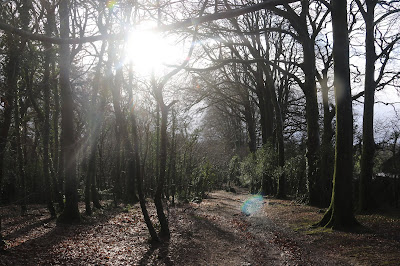It's been ages since Mrs P and myself had an international adventure and, as yesterday's weather was predicted to be good, we decided to use our permitted 'travel a reasonable distance for exercise' allowance to venture over the border into Devon. Travelling ten miles was, we thought, well within the spirit of Lockdown V2. It turned out to be a delightful and allowed us to see some familiar sights from a different angle - looking at them rather than looking from them. And, for the first time for ages, I took my infra-red adapted DSLR with me.
 |
| Our route started and ended in the car park at Bere Alston station (is it really almost 50 years since we used to occasionally catch a train from here into Plymouth?). We dropped down to the banks of the Tamar and then headed upstream to near Tuckermarsh Quay, to climb back up to the station. The elevation profile for the walk shows it quite nicely. Distance? I clocked it at 5.2 miles. As I said above, it was a delightful walk and took us through some quiet nooks and crannies' that we've never come across before. |
 |
| The Tamar Valley service railway lines at Bere Alston station. As there's only about 6 trains a day, it wasn't too hazardous to get onto the track. The line to the left goes to Plymouth and that to the right heads for Calstock and Gunnislake. At Bere Alston, the driver gets out, gets into what was the rear of the train and then drives the train onwards. |
 |
| The leaf-strewn path by the side of the river. Very autumnal and very pleasant to walk on, with much rustling underfoot. |
 |
| Looking downstream towards the Pentillie loop in the river. Not a view that we see very often as the 'other side' does not have any footpaths or roads. |
 |
| It's a good year for holly berries. And fruit and nuts generally. |
 |
| A leafy pattern - looking down. |
 |
| Ditto - looking up. |
 |
| Looking down the river from were we stopped for refreshments. It was so quite, just the lapping of the water and the call of a couple of buzzards circling above. |
 |
| Looking across the river to the hamlet of Bohetherick. It's always had a lot of market gardens and, look carefully, you can see rows of Pittosporum bushes that are used as foliage plants for floral arrangements. |
 |
| How many times have we been to the quay at Cotehele and looked across to where we are now? Too many to mention. At one time, I would imagine that there would have been a ferry acorss the river at this point. |
 |
Ahead of us is Danesombe Valley House. Originally built in the 1850s as a fishing lodge, it was a hotel for many years. Nowadays it's a family home, with spectacular views up and down the river. This photograph was taken whilst we were walking along the bund bordering the broad curve that takes the river into Calstock. Most of the leaves are off the trees on the Cornwall side.
|
 |
| Looking through the reeds across to Cornwall. |
 |
| The river is to the left and we are walking towards the Calstock viaduct. |
 |
| We rarely get to see the viaduct from this angle. |
 |
| Although they may look like granite blocks, the viaduct is actually constructed of concrete blocks made on site on the Devon side. |
 |
| The viaduct again with the old chapel to the right. It's now an arts' centre and has an amazing view from the main auditorium. |
 |
| I think both versions of this shot bring something different. |
 |
| The 3.30 train to Plymouth crossing the viaduct. |
 |
| A metalled road is a road surface with small stones, possibly bound together with bitumen, tar, or whatever.. The word itself from the Latin 'metallum', meaning 'quarry'. |
 |
| A tapestry of colours in the woods opposite Calstock. |
 |
| The sunken lane leading steeply down, and up, to Tuckermarsh quay, giving access to the Tamar for local produce from the Devon side. In parts, this trackway was carved out of the bedrock and the effort of doing this must indicate that it was important in its time. The coming of the railway probably saw the end of the use of it. |
 |
| Early Xmas lights at Bere Alston station. |






























































